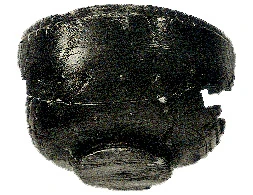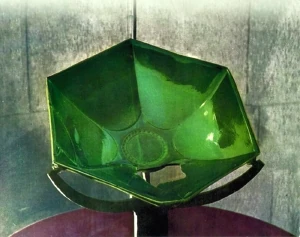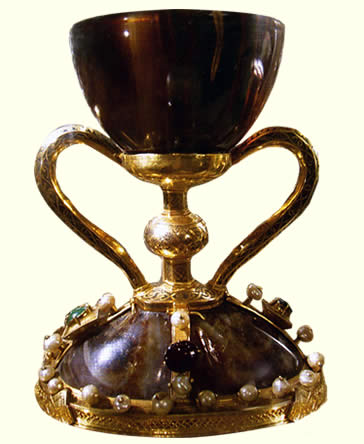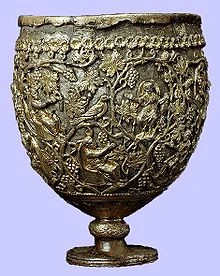The Holy Grail is a dish, plate, stone, or cup around which an important theme of Arthurian literature revolves. A grail, wondrous but not explicitly "holy", first appears in Perceval le Gallois, an unfinished romance by Chrétien de Troyes; it is a processional salver used to serve at a feast. Chretien's story attracted many continuators, translators and interpreters in the later 12th and early 13th centuries, including Wolfram von Eschenbach, who makes the grail a great precious stone that fell from the sky. The Grail legend became interwoven with legends of the Holy Chalice. The connection with Joseph of Arimathea and with vessels associated with the Last Supper and crucifixion of Jesus, dates from Robert de Boron's Joseph d'Arimathie (late 12th century) in which Joseph receives the Grail from an apparition of Jesus and sends it with his followers to Great Britain. Building upon this theme, later writers recounted how Joseph used the Grail to catch Christ's blood while interring him and how he founded a line of guardians to keep it safe in Britain. The legend may combine Christian lore with a Celtic myth of a cauldron endowed with special powers.
Origin[]

From the Collection of Dr. James Smythe. Reputed to be the Holy Grail.
The word graal, as it is earliest spelled, comes from Old French graal or greal, cognate with Old Provençal grazal and Old Catalan gresal, meaning "a cup or bowl of earth, wood, or metal" (or other various types of vessels in Southern French dialects). The most commonly accepted etymology derives it from Latin gradalis or gradale via an earlier form, cratalis, a derivative of crater or cratus which was, in turn, borrowed from Greek krater (a two-handed shallow cup). Alternate suggestions include a derivative of cratis, a name for a type of woven basket that came to refer to a dish, or a derivative of Latin gradus meaning "'by degree', 'by stages', applied to a dish brought to the table in different stages or services during a meal".
The Grail was considered a bowl or dish when first described by Chrétien de Troyes. Hélinand of Froidmont described a grail as a "wide and deep saucer" (scutella lata et aliquantulum profunda). Other authors had their own ideas: Robert de Boron portrayed it as the vessel of the Last Supper; and Peredur had no Grail per se, presenting the hero instead with a platter containing his kinsman's bloody, severed head. In Parzival, Wolfram von Eschenbach, citing the authority of a certain (probably fictional) Kyot the Provençal, claimed the Grail was a stone (called lapis exillis) that fell from Heaven, and had been the sanctuary of the neutral angels who took neither side during Lucifer's rebellion. The authors of the Vulgate Cycle used the Grail as a symbol of divine grace. Galahad, illegitimate son of Lancelot and Elaine, the world's greatest knight and the Grail Bearer at the castle of Corbenic, is destined to achieve the Grail, his spiritual purity making him a greater warrior than even his illustrious father. Galahad and the interpretation of the Grail involving him were picked up in the 15th century by Sir Thomas Malory in Le Morte d'Arthur, and remain popular today.
According to the Catholic Encyclopedia, after the cycle of Grail romances was well established, late medieval writers came up with a false etymology for sangréal, an alternative name for "Holy Grail." In Old French, san graal or san gréal means "Holy Grail" and sang réal means "royal blood"; later writers played on this pun. Since then, "Sang real" is sometimes employed to lend a medievalising air in referring to the Holy Grail. This connection with royal blood bore fruit in a modern bestseller linking many historical conspiracy theories (see below).
Legends and Location[]
Belief in the Grail and interest in its potential whereabouts has never ceased. Ownership has been attributed to various groups (including the Knights Templar, probably because they were at the peak of their influence around the time that Grail stories started circulating in the 12th and 13th centuries).
There are cups claimed to be the Grail in several churches, for instance the Saint Mary of Valencia Cathedral, which contains an artifact, the Holy Chalice, supposedly taken by Saint Peter to Rome in the 1st century, and then to Huesca in Spain by Saint Lawrence in the 3rd century. According to legend, the monastery of San Juan de la Peña, located at the south-west of Jaca, in the province of Huesca, Spain, protected the chalice of the Last Supper from the Islamic invaders of the Iberian Peninsula. Archaeologists say the artifact is a 1st century Middle Eastern stone vessel, possibly from Antioch, Syria (now Turkey); its history can be traced to the 11th century, and it now rests atop an ornate stem and base, made in the Medieval era of alabaster, gold, and gemstones. It was the official papal chalice for many popes, and has been used by many others, most recently by Pope Benedict XVI, on July 9, 2006. The emerald chalice at Genoa, which was obtained during the Crusades at Caesarea Maritima at great cost, has been less championed as the Holy Grail since an accident on the road, while it was being returned from Paris after the fall of Napoleon, revealed that the emerald was green glass.
In Wolfram von Eschenbach's telling, the Grail was kept safe at the castle of Munsalvaesche (mons salvationis), entrusted to Titurel, the first Grail King. Some, not least the Benedictine monks of Montserrat, have identified the castle with the real sanctuary of Montserrat in Catalonia, Spain. Other stories claim that the Grail is buried beneath Rosslyn Chapel or lies deep in the spring at Glastonbury Tor. Still other stories claim that a secret line of hereditary protectors keep the Grail, or that it was hidden by the Templars in Oak Island, Nova Scotia's famous "Money Pit", while local folklore in Accokeek, Maryland says that it was brought to the town by a closeted priest aboard Captain John Smith's ship.
Claimed Grails[]
The Jerusalem Chalice[]
The earliest record of a chalice from the Last Supper is the account of Arculf a 7th-century Anglo-Saxon pilgrim who described it in De locis sanctis as being located in a reliquary in a chapel near Jerusalem, between the basilica of Golgotha and the Martyrium. He described it as a two-handled silver chalice with the measure of a Gaulish pint. Arculf kissed his hand and reached through an opening of the perforated lid of the reliquary to touch the chalice. He said that the people of the city flocked to it with great veneration. (Arculf also saw the Holy Lance in the porch of the basilica of Constantine.) This is the only mention of the Holy Chalice being situated in the Holy Land.
The Genoa Chalice[]
Of two vessels that survive today, one is at Genoa, in the cathedral. The hexagonal vessel is known as the sacro catino, the holy basin. Traditionally said to be carved from emerald, it is in fact a green Egyptian glass dish, about fourteen inches (35 cm) across. It was sent to Paris after Napoleon’s conquest of Italy, and was returned broken, which identified the emerald as glass. Its origin is uncertain; according to William of Tyre, writing in about 1170, it was found in the mosque at Caesarea in 1101: "a vase of brilliant green shaped like a bowl." The Genoese, believing that it was of emerald, accepted it in lieu of a large sum of money. An alternative story in a Spanish chronicle says that it was found when Alfonso VII of Castile captured Almería from the Moors in 1147 with Genoese help, un vaso de piedra esmeralda que era tamanno como una escudiella, "a vase carved from emerald which was like a dish". The Genoese said that this was the only thing they wanted from the sack of Almería. The identification of the sacro catino with the Holy Chalice is not made until later, however, by Jacobus de Voragine in his chronicle of Genoa, written at the close of the 13th century.
The Valencia Chalice[]
The other surviving Holy Chalice vessel is the santo cáliz, an agate cup in the Cathedral of Valencia. It is preserved in a chapel consecrated to it, where it still attracts the faithful on pilgrimage.
The piece is a hemispherical cup made of dark red agate which is mounted by means of a knobbed stem and two curved handles onto a base made from an inverted cup of chalcedony. The agate cup is about 9 centimeters/ 3.5 inches in diameter and the total height, including base, is about 17 centimeters/ 7 inches high. The agate cup, without the base, fits a description by Saint Jerome. The lower part has Arabic inscriptions.
After an inspection in 1960, the Spanish archaeologist Antonio Beltrán asserted that the cup was produced in a Palestinian or Egyptian workshop between the 4th century BC and the 1st century AD. The surface has not been dated by microscopic scanning to assess recrystallization.
The Chalice of Valencia comes complete with a certificate of authenticity, an inventory list on vellum, said to date from AD 262, that accompanied a lost letter of which details state-sponsored Roman persecution of Christians that forces the church to split up its treasury and hide it with members, specifically the deacon Saint Lawrence. It goes on to enumerate all precious items. The physical properties of the Holy Chalice are described and it is stated the vessel had been used to celebrate Mass by the early Popes succeeding Saint Peter.
The first explicit inventory reference to the present Chalice of Valencia dates from 1134, an inventory of the treasury of the monastery of San Juan de la Peña drawn up by Don Carreras Ramírez, Canon of Zaragoza, December 14, 1134: "En un arca de marfil está el Cáliz en que Cristo N. Señor consagró su sangre, el cual envió S. Lorenzo a su patria, Huesca". According to the wording of this document, the Chalice is described as the vessel in which "Christ Our Lord consecrated his blood".
Reference to the chalice is made in 1399, when it was given by the monastery of San Juan de la Peña to king Martin I of Aragon in exchange for a gold cup. By the end of the century a provenance for the chalice can be detected, by which Saint Peter had brought it to Rome.
Pope John Paul II himself celebrated mass with the Holy Chalice in Valencia in November 1982, causing some uproar both in skeptic circles and in the circles that hoped he would say accipiens et hunc praeclarum Calicem ("this most famous chalice") in lieu of the ordinary words of the Mass taken from Matthew 26:27). For some people, the authenticity of the Chalice of Valencia failed to receive papal blessing.
In July 2006, at the closing Mass of the 5th World Meeting of Families in Valencia, Pope Benedict XVI also celebrated with the Holy Chalice, on this occasion saying "this most famous chalice", words in the Roman Canon said to have been used for the first popes until 4th century in Rome, and supporting in this way the tradition of the Holy Chalice of Valencia. This artifact has seemingly never been accredited with any supernatural powers, which legend apparently confines to other relics such as the Holy Grail, the Holy Lance and the True Cross.
In Saint Laurence and the Holy Grail, Janice Bennett gives an account of the chalice's history, carried on Saint Peter's journey to Rome, entrusted by Pope Sixtus II to Saint Lawrence in the third century, sent to Huesca in Spain when the Hispanic saint was martyred on a gridiron during the Valerian persecution in Rome in AD 258, sent to the Pyrenees for safekeeping, where it passed from monastery to monastery, in accordance with all the claims to former possession of the Chalice, and venerated by the monks of the Monastery of San Juan de la Peña. Emerging there into the light of history, the monastery's agate cup was acquired by King Martin I of Aragon in 1399 who kept it at Zaragoza. After his death, King Alfonso V of Aragón brought it to Valencia, where it has remained.
Bennett presents as historical evidence a 6th-century manuscript Latin Vita written by Donato, an Augustinian monk who founded a monastery in the area of Valencia, which contains circumstantial details of the life of Saint Laurence and details surrounding the transfer of the Chalice to Spain. The original manuscript does not exist, but a 17th-century Spanish translation entitled "Life and Martyrdom of the Glorious Spaniard St. Laurence" is in a monastery in Valencia. The main source for the life of St. Laurence, the poem Peristephanon by the 5th-century poet Prudentius, does not mention the Chalice that was later said to have passed through his hands.
In 1960 the Spanish archeologist Antonio Beltrán studied the Chalice and concluded: "Archeology supports and definitively confirms the historical authenticity". "Everyone in Spain believes it is the cup," Bennett said to a reporter from the Denver Catholic Register. "You can see it every day that the chapel is open."
The Antioch Chalice[]
The silver-gilt object originally identified as an early Christian chalice is in the collection of the Metropolitan Museum of Art in New York City, It was apparently made at Antioch in the early 6th century and is of double-cup construction, with an outer shell of cast-metal open work enclosing a plain silver inner cup. When it was first recovered in Antioch just before World War I, it was touted as the Holy Chalice, an identification the Metropolitan Museum characterizes as "ambitious". It is no longer identified as a chalice, having been identified by experts at Walters Art Museum in Baltimore, Maryland, believed to be a standing lamp, of a style of the 6th century.
Bureau File[]
The only such object that is known to have any power, holy or otherwise was lost in the Levant in 1938. It is known only from the report by Dr. Henry Jones Jr. It is reported to be a gilded clay cup that he witnessed performing miracles, including saving his Father's life.
A second cup made of wood and badly worn from the veneration it has received is in the collection of Dr. James Smythe. Smythe claims this is the Glastonbury grail. A cup protected by the Knights Templer. A cup that was their downfall. He reports it has power, but does not explain the power or offer to demonstrate it, other than to say that everyone that has used the cup, and lost it has suffered devastating loss and destruction. And everyone that has used it, has lost it. He has not used it and will not.
"There is a price to every magic and woe betide he that calls on magic before he knows the price." -- Dr. James Smythe.



